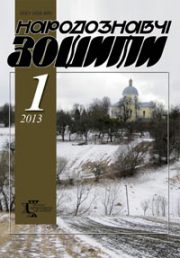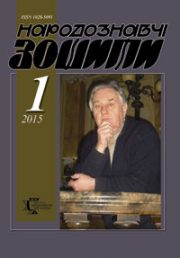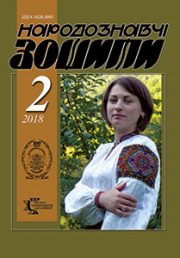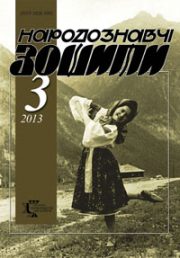The Ethnology Notebooks. 2023. № 1 (169), 147—162
UDK 738.8(477.83-25)”18/19″
DOI https://doi.org/10.15407/nz2023.01.147
POTTERS FROM LEMKIVSHCHYNA AND THEIR CONTRIBUTION INTO THE DEVELOPMENT OF UKRAINIAN FOLK EARTHENWARE
IVASHKIV Halyna
- ORCID ID: htps://orcid.org/0000-0003-2359-6735
- Doctor of Art Criticism, Senior researcher,
- Head of the sector «Centre for Studies into Ukrainian Pottery»;
- The Ethnology Institute at the National Academy of Sciences of Ukraine,
- Folk Art Department,
- 15, Svoboda Ave., 79000, Lviv, Ukraine,
- Contacts: e-mail: halia_503@ukr.net
Abstract. The question of ceramic centres, as well as artistic peculiarities of the earthenware from Lemkivshchyna is topical, since it has never been an object of a detailed research. Therefore, the aim of this articleis to analyze the development of pottery production in Lemkivshchyna, and we will limit ourselves to the territory of present-day Poland. The subject of the research is the earthenware by Lemko potters, while the object is the potters’ activity and artistic specificity of their works. Methodologically, the paper is based on principles of systematicity, historism and comparativity applying cultural-historical, and comparative-typological methods. The given article is based on such materials as the earthenware from museum funds, archive records and internet resources.
There is not much data on Lemko pottery centres in scientific and popular science literature. Certain aspects have been highlighted in the works by Yu. Tarnovych, K. Mateiko, I. Dobrianska, I. Verkhratskyi, Z. Hanudel, T. Hontar, M. Muszynka, О. Koshovyi, R. Motyl, and H. Ivashkiv. Some facts on Lemko pottery can be found in «The Chronicles» of Taras Shevchenko Scholarly Society, newspapers and journals «The Business», «The Life and Knowledge», «The Ukrainian news», «Our Word», and «Polska Sztuka Ludowa». In the course of research we have established that there were more than ten ceramic centres on the territory of Lemkivshchyna, namely Kołaczyce, Mezhybrody, Milik, Mrzygłуd, Muszyna, Nowy Sącz, Odrzechowa, Podegrady, Poraż, Stary Sącz and Sanok.
The earliest record on pottery production on the lands of Lemkivshchyna dates back to the 16th c., whereas it reached its peak there and on the whole territory of Ukraine in the late 19th early 20th cc.
Particular attention should be paid to the question of authorship of Lemko earthenware, as the potters rarely signed their works. The article characterizes works by Andriy Kalish from Stary Sącz, who made pots, jugs, cups, bowls, lids and flowerpots. In decor of his earthenware the potter used various decoration techniques, such as scratching, «horning», partial or full glazing, rarely some relief images. Pottery in Lemkivshchyna was developing within general tendencies in Ukraine, and this can be seen in traditional shapes, technology, decoration techniques, etc.
Keywords: Lemkivshchyna, earthenware, potters, typology, shape, décor.
Received 27.12.2022
REFERENCES
- (1988). Lemkivshchyna. The land — the people — history — culture (Vol. 2).New York; Paris; Sidney; Toronto [in Ukrainian].
- Tarnovych, Yu. (1988). The Illustrated history of Lemkivshchyna (second edition, Lviv, 1936). Lviv [in Ukrainian].
- Tarnovych, Yu. (1941). Lemkivshchyna. Material culture. Krakow [in Ukrainian].
- Reinfuss, R. (1948). The Lemkos as an ethnographic group. Papers and ethnographic materials. Lublin [in Polish].
- Reinfuss, R. (1963). The Lemkos in the past and now. The Lemkos: culture — art — language. Sanok [in Polish].
- Rieger, J. (1983). The Lemkos and their language. The Lemkos: culture — art — language. Sanok [in Polish].
- Krasovskyi, I. (1988). An ethnography outline: the north. Material culture. Lemkivshchyna. The land — the people — history — culture (Vol. 2). New York; Paris; Sidney; Toronto[in Ukrainian].
- Mateiko, K.I. (1959). Folk earthenware of the western parts of Ukrainian SSR. A historical and ethnographical research. Kyiv [in Ukrainian].
- Mateiko, K.I. (1956). Ukrainian folk earthenware. A guidebook on the funds of Ukrainian state museum of ethnography and crafts at the USSR Academy of sciences. Kyiv [in Ukrainian].
- Dobrianska, І. (1964). An outline on material and intellectual culture of the Lemkos. Our word, 14 [in Ukrainian].
- Verkhratskyi, І. (1902). On the dialect of Halychyna Lemkos. A collection of papers of the philological section of Taras Shevchenko Scholarly Society (Vol. V). Lviv [in Ukrainian].
- Hanudel, Z. (1976). The names of crockery and kitchen utensils in Ukrainian dialects of Eastern Slovakia. A collection of scholarly papers on Ukrainian culture (Vol. 8, pp. 249—267). Svydnyk; Presov [in Ukrainian].
- Hontar, Т., & Muszynka, M. (2002). Lemko’s food. Lemkivshchyna: in 2 vol. Intellectual culture (Vol. 2, pp. 347—359). Lviv [in Ukrainian].
- Koshovyi, O. (2002) Ceramics. Lemkivshchyna: in 2 vol. Intellectual culture (Vol. 2, pp. 330—338). Lviv [in Ukrainian].
- Koshovyi, O., Motyl, R., & Pavliuk, S.P. (Ed.). (2020). Ceramics. Ethnographical groups of the Ukrainians from the Carpathians. The Lemkos (Pp. 285—292). Kharkiv: Folio [in Ukrainian].
- Ivashkiv, H. (2007). Decor of Ukrainian folk earthenware of the 16th — first half of the 20th cc. Lviv [in Ukrainian].
- Ivashkiv, H., Halczak, B., & Drozd., R. (Eds.). (2019—2020). The earthenware from Lemkivshchyna in Ukrainian and Polish museums. The Ukrainians and their neighbours across centuries: politics, economy, religion, culture and everyday life. Slupsk; Warsaw: Ukrainian Historical Society in Poland: Sea Academy in Slupsk [in Ukrainian].
- (1936, may 12). Cultural activity in Lemkivshchyna (general meetings of the museum society «Lemkivshchyna» in Sanok). Dilo, 104 [in Ukrainian].
- Sydor, О. (1995). Lev Getz and the museum «Lemkivshchyna» in Sanok. Monuments of Ukraine: history and culture, 3 [in Ukrainian].
- The archives of the Ethnology Institute at the National Academy of sciences of Ukraine. File 10. Od. save 2 [in Ukrainian].
- The inventory book of the Museum of Taras Shevchenko Scholarly Society, 7 (23885—26028) [in Ukrainian].
- (1877). The catalogue of agricultural and industrial exhibition in Lviv 1877. Lviv [in Polish].
- (1939). The Chronicles of Taras Shevchenko Scholarly Society from 26.12.1937 till 31.12.1938 (Part 74). Lviv [in Ukrainian].
- State Archives of the Lviv oblast. F. 1245. Op. 1. Spr. 94 [in Ukrainian].
- Krasovskyi, I. (2002). Lemkivshchyna in literature, art museum collections. Lemkivshchyna: in 2 vol. Intellectual culture (Vol. 2). Lviv [in Ukrainian].
- Retrieved from: http//іemky.com
- Getz, L. Recollections (manuscripts, records from September 13 and 14, 1940) [in Ukrainian].
- Kokovskyi, F. (1936). The Museum «Lemkivshchyna». Life and knowledge, 9 [in Ukrainian].
- Hrushevskyi, M. (Ed.). (1897). Descriptions of kingdoms on Rus lands of the 16th p.: Illustrations from Przemysl and Sanok lands. Resources for the history of Rus Ukraine (Vol. 2). Lviv [in Ukrainian].
- The book of session protocols of acceptance and liberation of potters’ workshops. 1685—1793. Central State Archive of Ukraine. F. 52. Op. 2. Spr. 968 Lviv [in Ukrainian].
- Stary, Sacz. (1889). The dictionary of geographical names of the Polish kingdom and other Slavonic lands (Vol. 10). Warsaw [in Polish].
- (1930). The Renaissance, 10—12 [in Ukrainian].
- Dobrianska, I. (1964). The outline of material and intellectual culture of the Lemkos. Our word, 20 [in Ukrainian].
- Syvak, V.M., & Sopolyha, M. (1999). The interior of the house. Traditional furniture. Lemkivshchyna: in 2 vol. (Vol. 1: Material culture). Lviv [in Ukrainian].
- Dobrianska, I. (1963). An outline on material and intellectual culture of the Lemkos. Our word, 52 [in Ukrainian].
- Ivashkiv, H. (2007). Vasyl Shostopalets and the earthenware of Sokal. Lviv [in Ukrainian].
- Ivashkiv, H., & Lozynskyi, T. (Eds.). (2012). Painted earthenware of Kosiv and Pistyn. Lviv [in Ukrainian].
- MEC.EP 48007.
- MEC.EP 48006.
- MEC.EP 47999.
- MEC.EP 47995.
- MEC.EP 47997.
- MEC.EP 47998.
- MEC.EP 47984.
- MEC.EP 47988.
- MEC.EP 48008.
- MEC.EP 68673.
- MEC.EP 48011.
- MEC.EP 48010.
- MEC.EP 48009.
- Ivashkiv, H. (2005). The grapheme of a spiral on the earthenware. Art criticism’05 (Pp. 41—54).Lviv [in Ukrainian].
- MEC.EP 48012.
- MEC.EP 48014.
- MEC.EP 48004.
- MEC.EP 48042.
- MEC.EP 48002.
- MEC.EP 48000.







